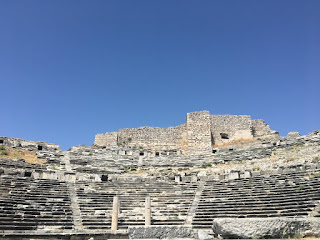In the words of our leader, David Palmer, “Day three is going to be hard to beat.” Indeed, this day was full of biblical sites and historical context.
The morning’s expedition brought us to the Temple of Apollo at Didyma along the Aegean Sea. The impressive temple was built by Alexander the Great and once held 122 columns each over 60 ft high. Within Asia, Didyma prided itself on its popularity as the center for oracles. At the Temple of Apollo, people would question the temple priestess with desires for the present and concerns over the future. Walking amidst the fallen columns, our minds entered the world of the past, the world of idolatry and false hope. The prominence of idolatry shaped the Greco-Roman world in which humans had no real relationship with the divine except to manipulate and sacrifice to lifeless statues. It was to this world that Paul brought the gospel, the story of a God who wants a relationship with his people, a God who is living and active, a God of faithfulness and covenant, a God who is higher than the thoughts of mankind.
The afternoon involved a journey to the theatre of Miletus, where Paul met with the Ephesians elders on his way to Jerusalem near the end of the book of Acts (Acts 20). The theatre is extremely well preserved and contains one of the most important extra-biblical inscriptions. A seat on the fifth row of the theatre is inscribed with a reservation for the Jews and the God-fearers. The God-fearers are mentioned several times in the narrative of Acts among those who heard Paul’s preaching. Yet, this stone is our only evidence of the God-fearers outside of the biblical narrative. These were the seekers of the ancient world—those who were drawn to worship the God of the Bible. They feared God. They attended the synagogue service. Yet, they were hesitant to take the final step of ritual circumcision and full conversion. The message of the gospel for all nations, brought great joy to these God-fearers. This was salvation for men and women, salvation that was based on faith in Jesus Christ. All who believed become full members of the family of God, the church of Christ. Throughout our journey, Paul’s audience continues to come into sharper focus as we observe the cultural and historical context of his ministry and meet his audience through the legacy they left behind.
Our final stop of the day was in the city of Smyrna (modern Izmir) along the coast. This is a beautiful, modern city that has never stopped being inhabited since Paul’s own day. We explored the recently excavated Roman agora, or marketplace in the heart of the modern city. We saw several important inscriptions in the lower level of the marketplace. However, the most impacting moment came as we stood in the market and looked toward the upper slopes of the city. The outline of an ancient stadium came clearly into view. Early in the second century AD, the leader of the church of Smyrna, Polycarp, gave his life in living testimony to Jesus Christ “my King who saved me.”
 |
| Temple of Apollo at Didyma |
 |
| Theater at Miletus |
 |
| God-fearers inscription |

Comments
Post a Comment
Comments are monitored and will be posted upon approval.